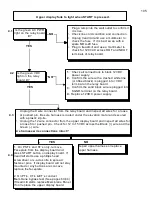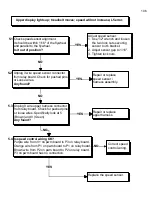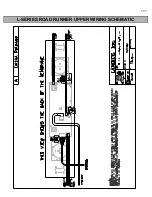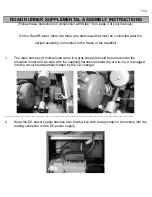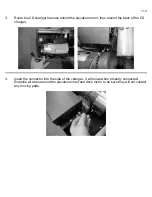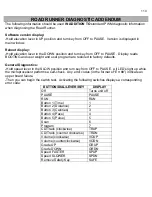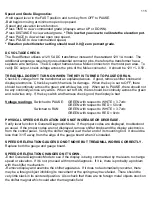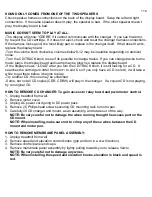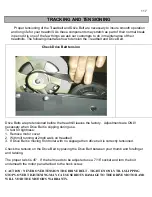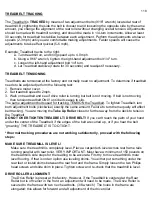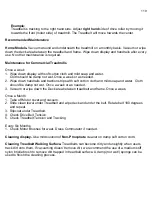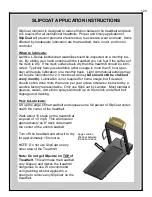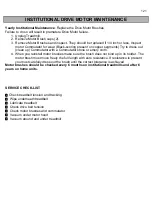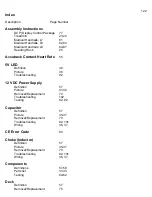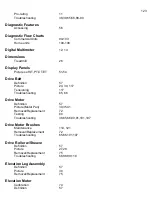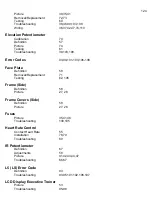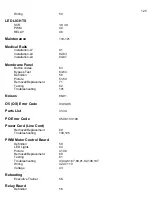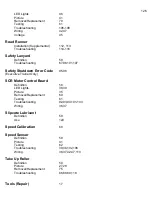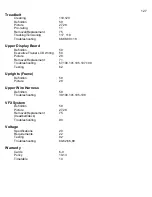
118
TREADBELT TRACKING
The Treadbelt is
TRACKED
by means of two adjustment bolts (9/16" wrench) located at rear of
treadmill. By tightening the side the belt is closest to and loosening the opposite side by the same
amount, you change the alignment of the rear roller without changing overall tension. Adjustments
should be made with treadmill running, and should be made in 1/4-turn increments. Allow at least
30 seconds for treadbelt to stabilize between each adjustment. Perform the adjustments at slower
speeds (2-3 mph) until you are comfortable making adjustments. Faster speeds will cause the
adjustments to take effect quicker (5-6 mph).
Example: Treadbelt tracks to the right:
a. Turn treadmill on, and bring speed up to 4.0 mph.
b. Using a 9/16" wrench, tighten the right-hand adjustment bolt 1/4" turn.
c. Loosen the left-hand adjustment bolt 1/4" turn.
d. Let Treadbelt stabilize (rotate for 30 seconds) and readjust if necessary.
TREADBELT TENSIONING
Treadbelts are tensioned at the factory and normally need no adjustment. To determine if treadbelt
needs to be adjusted perform the following test:
1. Remove motor cover.
2. Set treadmill speed to 2mph.
3. Walk on treadbelt and see if drive roller is turning but belt is not moving. If belt is not moving
then tension treadbelt ONLY until belt ceases to slip.
The same adjustment bolts used for tracking TENSION the Treadbelt. To tighten Treadbelt, turn
both adjustment bolts (clockwise) exactly the same amount. Failure to turn them equally will affect
belt tracking. You are moving the
Take Up Roller
closer or further away from the deck to tension
the Treadbelt.
DO NOT OVER TIGHTEN TREADBELT / DRIVE BELT!
If you can't reach the palm of your hand
under the center of the Treadbelt, if the edges of the belt are curled up, or if you hear the belt
“groaning” THE TREADBELT IS TOO TIGHT.
*If normal tracking procedures are not working satisfactorily, proceed with the following
steps:
MAKE SURE TREADMILL IS LEVEL!
Make sure the treadmill is completely level. Place a carpenter's level across rear frame rails
running parallel with rear roller. VERY IMPORTANT: Must have a minimum of 150 pounds on
the treadmill’s side steps for the reading to be accurate. First try to move treadmill to more
level flooring. If that is not an option use leveling shims. You either put something under the
rear feet or install shims between the rear foot and the frame. Simply loosen the two Philips
head screws and slide shim in place. Tighten screw and re-check that the treadmill is level.
DRIVE ROLLER ALIGNMENT:
The Drive Roller is preset at the factory. However, if the Treadbelt is centered at the Rear
Roller but is off center in the front, an adjustment will need to be made. The Drive Roller is
secured to the frame with two hex head bolts. (3/8 wrench) The holes in the frame are
elongated; this allows for forward and aft adjustment of the drive roller.
Summary of Contents for Cardio Trainer L8
Page 5: ...5 ...
Page 27: ...27 Section 3 Parts Identification L8 L9 BED EXPLODED VIEW 18 ...
Page 28: ...28 L7 BED EXPLODED VIEW L Series Upright ...
Page 29: ...29 L SERIES UPRIGHT EXPLODED VIEW 112 ...
Page 30: ...30 L SERIES MOTOR PAN EXPLODED VIEW 111 ...
Page 35: ...35 COMMERCIAL MOTOR PAN SCR MOTOR CONTROL BOARD ...
Page 36: ...36 L SERIES 110V COMMERCIAL LOWER WIRE SCHEMATIC ...
Page 37: ...37 L SERIES 220V COMMERCIAL LOWER WIRE SCHEMATIC ...
Page 40: ...40 L SERIES SCR UPPER WIRE HARNESS WIRING DIAGRAM ...
Page 42: ...42 L SERIES HOME MOTOR PAN WIRING SCHEMATIC ...
Page 47: ...47 L SERIES HOME MOTOR PAN WIRING SCHEMATIC PWM MOTOR CONTROL BOARD W RELAY ASSEMBLY ...
Page 48: ...48 PWM MOTOR CONTROL BOARD W RELAY ASSEMBLY ...
Page 49: ...49 L SERIES PWM UPPER WIRE HARNESS WIRING DIAGRAM ...
Page 50: ...50 EXECUTIVE TRAINER LCD WIRING SCHEMATIC ...
Page 110: ...110 L SERIES ROAD RUNNER LOWER WIRING DIAGRAM ...
Page 111: ...111 L SERIES ROAD RUNNER UPPER WIRING SCHEMATIC ...


